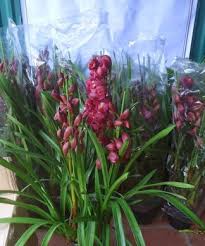# Famous Sato Cymbidium Orchid Varieties in Flower Competitions

Sato Cymbidium orchids, renowned for their striking beauty and exquisite forms, have become a staple in flower competitions worldwide. These orchids not only showcase a wide variety of colors and shapes but also demonstrate the skill and creativity of their cultivators. In this article, we will explore some of the most famous Sato Cymbidium orchid varieties that have made a mark in flower shows and competitions, examining their unique characteristics, histories, and the factors that contribute to their success on the competitive stage.
## 1. The Allure of Sato Cymbidium Orchids
Sato Cymbidium orchids, native to Asia, particularly Japan, have captivated enthusiasts and judges alike with their large, vibrant flowers and robust growth. Their hybrids have gained immense popularity in horticulture, leading to numerous cultivars celebrated for their exceptional qualities. These orchids are characterized by:
– **Variety of Colors**: Sato Cymbidium orchids come in a wide range of colors, including greens, yellows, pinks, reds, and whites. This spectrum allows for stunning combinations and arrangements that catch the eye.
– **Large Flower Size**: The flowers can be impressively large, making them stand out in competitions. Their size adds to their visual impact, allowing them to command attention.
– **Long-Lasting Blooms**: One of the most appealing features of Sato Cymbidium orchids is their longevity. They can bloom for several weeks, maintaining their beauty throughout the competition.
## 2. Factors Influencing Competition Success
Before diving into specific varieties, it’s essential to understand what judges typically look for in Sato Cymbidium orchids during competitions. Several factors influence the overall success of an orchid in a competitive setting:
### a. Flower Quality
The quality of the flowers is paramount in competitions. Judges assess the size, shape, color, and overall health of the blooms. Exceptional specimens have:
– **Well-Defined Petals**: Each petal should be perfectly formed, with no blemishes or deformities.
– **Vibrant Coloration**: The color intensity must be consistent across the flower, with no fading or discoloration.
– **Symmetry**: A well-balanced flower that appears symmetrical is often favored.
### b. Plant Health
The overall health of the plant is crucial. Healthy plants typically exhibit:
– **Vibrant Green Foliage**: Leaves should be free from spots or discoloration, indicating good health and proper care.
– **Strong Roots**: A healthy root system is essential for nutrient absorption and overall plant vitality.
### c. Presentation and Arrangement
Presentation can significantly impact a flower’s competitiveness. Judges consider:
– **Potting and Arrangement**: The choice of pot and how the plant is arranged can enhance its visual appeal.
– **Cleanliness**: The overall presentation should be clean and polished, reflecting the grower’s dedication.
## 3. Notable Sato Cymbidium Varieties
Several Sato Cymbidium varieties have earned accolades in flower competitions. Below are some of the most notable ones, along with their unique characteristics:
### a. **Cymbidium Sato Green**
**Description**: Known for its lush, green blooms, Cymbidium Sato Green is a favorite among judges. The flowers are large, with a delicate sheen that enhances their appearance.
**Competition Success**: This variety has consistently performed well in competitions due to its unique color, which stands out against traditional floral colors. Its striking appearance often garners attention and admiration from both judges and spectators.
**Care Requirements**: Cymbidium Sato Green thrives in moderate light conditions, with careful attention to watering to maintain its vibrant color and healthy foliage.
### b. **Cymbidium Golden Charm**
**Description**: This hybrid is celebrated for its bright, golden-yellow flowers that radiate warmth and joy. The blooms are often larger than average, with a unique cupped shape that adds elegance.
**Competition Success**: Cymbidium Golden Charm has earned numerous awards for its stunning color and size, making it a popular choice in flower shows. Its ability to hold its blooms for an extended period also contributes to its competitive edge.
**Care Requirements**: Golden Charm requires bright, indirect light and regular feeding to promote optimal growth and flowering.
### c. **Cymbidium Midnight Star**
**Description**: Featuring deep, dark burgundy flowers, Cymbidium Midnight Star is known for its dramatic appearance. The flowers are adorned with subtle, contrasting markings that add depth and intrigue.
**Competition Success**: This variety has gained a reputation for excellence in competitions due to its unique coloration and striking presence. Judges often commend its boldness and the rarity of its color.
**Care Requirements**: Midnight Star prefers slightly cooler temperatures and bright but indirect light, making it essential for growers to monitor its environment closely.
### d. **Cymbidium Happy Girl**
**Description**: A delightful hybrid, Cymbidium Happy Girl is characterized by its vibrant pink flowers that exude cheerfulness. The blooms are often accompanied by a sweet fragrance, enhancing their appeal.
**Competition Success**: This variety consistently attracts attention in competitions, thanks to its charming color and pleasant scent. Its lively presentation often earns it accolades for creativity and aesthetic appeal.
**Care Requirements**: Happy Girl thrives in well-drained potting mix and benefits from regular misting to maintain humidity levels.
### e. **Cymbidium Orange Delight**
**Description**: Known for its bright orange blooms, Cymbidium Orange Delight adds a pop of color to any arrangement. The flowers are medium-sized and arranged in clusters, creating a cheerful display.
**Competition Success**: This variety’s vibrant color and well-defined shape make it a favorite among judges, leading to numerous awards in flower shows. Its unique color sets it apart from other entries.
**Care Requirements**: Orange Delight prefers bright light and should be watered thoroughly but allowed to dry slightly between watering sessions to prevent root rot.
### f. **Cymbidium White Pearl**
**Description**: The elegant white flowers of Cymbidium White Pearl symbolize purity and beauty. These blooms are known for their smooth texture and pristine appearance.
**Competition Success**: White Pearl has excelled in competitions due to its timeless elegance and classic appeal. Its ability to complement other flowers in arrangements also makes it a popular choice.
**Care Requirements**: This variety thrives in bright, filtered light and requires careful watering to maintain its pristine white color.
## 4. The Role of Cultivators in Competitive Success
The success of Sato Cymbidium orchids in competitions is not only attributed to the flowers themselves but also to the skill and dedication of their cultivators. Cultivators play a vital role in the growth and preparation of these orchids for competitive shows.
### a. Selection of Varieties
Cultivators carefully select the best varieties to grow, focusing on those that exhibit exceptional qualities. They often experiment with hybridization to create unique cultivars that stand out in competitions.
### b. Care and Maintenance
Meticulous care is essential for successful orchids. Cultivators must provide the right balance of light, water, nutrients, and temperature to ensure optimal growth. This includes:
– **Regular Fertilization**: Proper fertilization schedules help promote healthy growth and blooming.
– **Pest and Disease Management**: Vigilant monitoring for pests and diseases is crucial to maintain plant health.
### c. Preparation for Competitions
As competitions approach, cultivators often step up their preparation efforts. This can include:
– **Training the Plants**: Cultivators may stake or tie blooms to ensure they maintain an upright position for maximum visual impact.
– **Enhancing Presentation**: Thoughtful arrangements and pot selections can elevate the overall presentation of the orchids.
## 5. Conclusion
Sato Cymbidium orchids are not just beautiful plants; they are a testament to the dedication and skill of cultivators who strive for excellence in flower competitions. The famous varieties we’ve explored in this article have earned their places in the spotlight through their unique characteristics and stunning appearances. As we continue to celebrate these extraordinary orchids, we also recognize the importance of proper care and maintenance in achieving competitive success.
In the world of flower competitions, Sato Cymbidium orchids stand out not only for their visual appeal but also for their rich histories and the stories behind their cultivation. Each variety has its own unique charm, contributing to the diverse and vibrant tapestry of the orchid community. Whether you are an experienced cultivator or a novice enthusiast, there is much to learn and appreciate about these remarkable plants. By understanding their characteristics and care requirements, you can embark on your journey to cultivate your own award-winning Sato Cymbidium orchids, bringing their beauty and joy into your home and community.
## Famous Sato Cymbidium Orchid Varieties in Flower Competitions (Part 2)
In the first part of this article, we explored some of the most notable Sato Cymbidium orchid varieties that have excelled in flower competitions, highlighting their unique characteristics and the factors contributing to their competitive success. In this second part, we will delve deeper into additional famous varieties, discuss cultivation tips for these orchids, and examine how to prepare them for competitions. This comprehensive exploration aims to equip both aspiring and experienced orchid enthusiasts with the knowledge needed to cultivate and showcase these stunning flowers effectively.
### 6. Additional Notable Varieties of Sato Cymbidium Orchids
While we previously covered several acclaimed varieties, there are many more Sato Cymbidium orchids that have garnered recognition in flower shows. Each of these varieties possesses its unique attributes that contribute to its popularity among growers and judges alike.
#### a. **Cymbidium Amy A. O’Brien**
**Description**: Known for its captivating lavender blooms, Cymbidium Amy A. O’Brien features petals that radiate a delicate softness. The flowers often showcase a gradient effect, transitioning from a light lavender to a deeper shade at the edges.
**Competition Success**: This variety frequently appears in award-winning displays due to its stunning color and unique appearance. Its graceful shape and delicate hues make it a favorite among judges who appreciate elegance and charm.
**Care Requirements**: Amy A. O’Brien thrives in bright, indirect sunlight and requires regular watering to keep the roots moist. It also benefits from a well-draining orchid mix to prevent root rot.
#### b. **Cymbidium Laura Lee**
**Description**: Cymbidium Laura Lee is celebrated for its bright orange and red blooms, which create a vibrant and eye-catching display. The large flowers are often arranged in cascading clusters, adding to their visual appeal.
**Competition Success**: This variety has consistently performed well in competitions, earning recognition for its vibrant colors and striking appearance. Its ability to maintain strong blooms for an extended period enhances its competitiveness.
**Care Requirements**: Laura Lee requires plenty of light to thrive, with some direct sunlight during the day. Proper watering and feeding during the growing season are essential for optimal health and blooming.
#### c. **Cymbidium Sunset Glow**
**Description**: With its warm, sunset-like coloration, Cymbidium Sunset Glow features rich yellow and orange blooms. The flowers often have a beautiful sheen, catching the light and creating a dazzling effect.
**Competition Success**: Sunset Glow is highly regarded in flower shows for its unique coloration and overall health. Judges appreciate the depth of color and the sheer size of the blooms, making it a top contender in competitions.
**Care Requirements**: This variety thrives in well-drained potting media and requires moderate light. Regular fertilization during the growing season helps to promote healthy growth and vibrant blooms.
#### d. **Cymbidium Plum Crazy**
**Description**: Cymbidium Plum Crazy is characterized by its deep, rich purple flowers with a glossy finish. The blooms have a distinct form, creating a dramatic visual impact that captivates viewers.
**Competition Success**: This variety stands out in competitions, often winning awards for its striking color and unique presentation. The bold hue makes it a favorite among judges looking for something different.
**Care Requirements**: Plum Crazy prefers a moderate amount of light, with some shade during the hottest part of the day. Adequate moisture is essential, and it should be watered when the top inch of soil feels dry.
### 7. Cultivation Tips for Sato Cymbidium Orchids
To achieve success with Sato Cymbidium orchids, particularly in competitive settings, it is essential to follow specific cultivation practices. Here are key tips for growing these orchids effectively:
#### a. Understanding Growing Conditions
– **Light Requirements**: Sato Cymbidium orchids generally prefer bright, indirect light. Some varieties may tolerate a few hours of direct sunlight, but excessive exposure can lead to leaf burn. Positioning your orchids near a window with filtered light or using sheer curtains can help provide optimal conditions.
– **Temperature Preferences**: These orchids thrive in moderate temperatures, typically between 60°F (15°C) and 80°F (27°C) during the day. Nighttime temperatures should be slightly cooler, promoting healthy growth and flowering.
– **Humidity Levels**: Maintaining adequate humidity is vital for the health of Sato Cymbidium orchids. Aim for humidity levels between 50% and 70%. Using a humidity tray or misting the plants regularly can help achieve these levels.
#### b. Potting and Soil
– **Choosing the Right Pot**: Select pots with drainage holes to prevent water accumulation, which can lead to root rot. Terracotta pots are often preferred, as they allow for better air circulation.
– **Soil Composition**: Use a well-draining orchid mix that allows for adequate airflow to the roots. A blend of bark, perlite, and sphagnum moss is often effective for Sato Cymbidium orchids.
#### c. Watering and Fertilization
– **Watering Schedule**: Water your orchids thoroughly, allowing excess water to drain out of the pot. Allow the top inch of the growing medium to dry out before the next watering. Overwatering can be detrimental, so monitoring moisture levels is crucial.
– **Fertilizing**: Use a balanced orchid fertilizer, diluted to half strength, during the growing season. Fertilize every two weeks to promote healthy growth and abundant flowering. Reduce feeding during the dormant period.
### 8. Preparing for Competitions
Preparation is key when it comes to showcasing Sato Cymbidium orchids in competitions. Follow these steps to ensure your orchids are ready for the spotlight:
#### a. Selecting the Right Specimen
Choose healthy, well-formed specimens for competition. Look for blooms that exhibit ideal characteristics, including size, color, and shape. The best specimens are often those that show no signs of damage or stress.
#### b. Grooming the Plant
– **Pruning**: Trim any dead or damaged leaves to improve the plant’s overall appearance. This not only enhances aesthetics but also promotes better air circulation.
– **Cleaning**: Wipe the leaves gently to remove dust and debris, allowing the plant to shine during the competition. Cleanliness is crucial in creating a polished presentation.
#### c. Staking and Support
For varieties with larger blooms, consider staking the flowers to maintain an upright position. Use soft ties to avoid damaging the petals and ensure the flowers are displayed prominently.
#### d. Presentation Techniques
– **Choosing the Right Pot**: Select a pot that complements the orchid’s colors and overall appearance. Decorative pots can enhance the presentation and attract attention.
– **Arranging the Display**: Experiment with arrangements that showcase the orchid’s beauty. Incorporating complementary flowers or foliage can create an eye-catching display.
### 9. Engaging with the Orchid Community
Participating in flower competitions is not only about showcasing individual orchids but also about engaging with a community of fellow enthusiasts. Building connections can enhance your experience and knowledge in orchid cultivation.
#### a. Joining Orchid Societies
Become a member of local or national orchid societies. These organizations often host events, competitions, and workshops where you can learn from experienced growers and share your experiences.
#### b. Attending Orchid Shows
Visiting orchid shows provides an opportunity to see a variety of orchids up close, including award-winning specimens. Networking with other growers and judges can offer valuable insights into cultivation practices and competition strategies.
#### c. Sharing Knowledge and Experiences
Consider hosting workshops or presentations on Sato Cymbidium orchids. Sharing your knowledge and experiences can inspire others and contribute to the broader orchid community.
### 10. Conclusion
Sato Cymbidium orchids are truly remarkable plants that have earned their place in flower competitions due to their stunning beauty and unique characteristics. In this article, we explored several famous varieties and the factors contributing to their success in competitive settings. By understanding their care requirements, preparation techniques, and the importance of community engagement, you can cultivate these exquisite orchids and participate in competitions with confidence.
As you embark on your journey with Sato Cymbidium orchids, remember that patience and dedication are essential. Each orchid has its unique personality, and nurturing them allows you to appreciate their beauty on a deeper level. Whether you are a seasoned grower or just starting, the world of Sato Cymbidium orchids offers endless possibilities for exploration and enjoyment. Embrace the challenge of cultivating these exceptional plants, and let their beauty shine in your garden and competitions.

